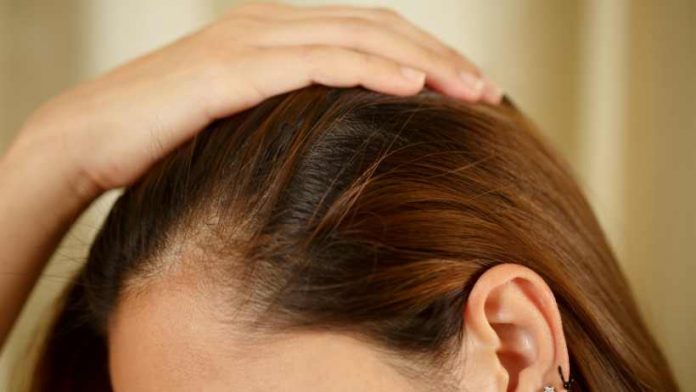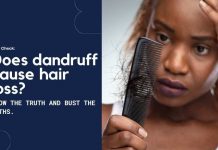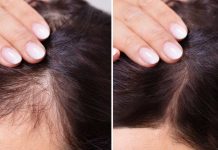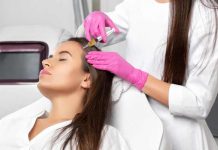Do you have a flaky or greasy scalp lately? It might be due to excess sebum build-up on the scalp. While your sebaceous glands secrete sebum to hydrate your hair to maintain its softness and silky texture, excess sebum might make your scalp oily [1]. The presence of too much sebum on the scalp might cause acne or dandruff, which would eventually lead to hair loss.
Overactive sebaceous glands might result from using certain haircare products, too much sweat, and more. Excess sebum mixed with dead cells, grime, dirt, and sweat makes your scalp look flaky and greasy. Sebum accumulation on the scalp will cause severe scalp infection and hair loss when not treated. Read on to learn about the role of sebum on the scalp, how fluctuations in sebum will affect you, and ways to maintain a healthy sebum level.
What is Sebum?
The sebaceous glands present in your skin’s dermal layer produce sebum, an oil-like substance that contains a complex lipid combination [2]. Sebum is a natural moisturizer for your body to nourish your hair and skin. The constitution of sebum comprises cholesterol, squalene, glycerides, free fatty acids, wax esters, and cholesterol esters [3].
It is considered the natural oil of your body that prevents dehydration of the skin, scalp and possesses antibacterial properties. Though sebum is essential for your scalp and skin, too much of it can be problematic for your body.
Why Excess Sebum Production Is Bad for Your Scalp?
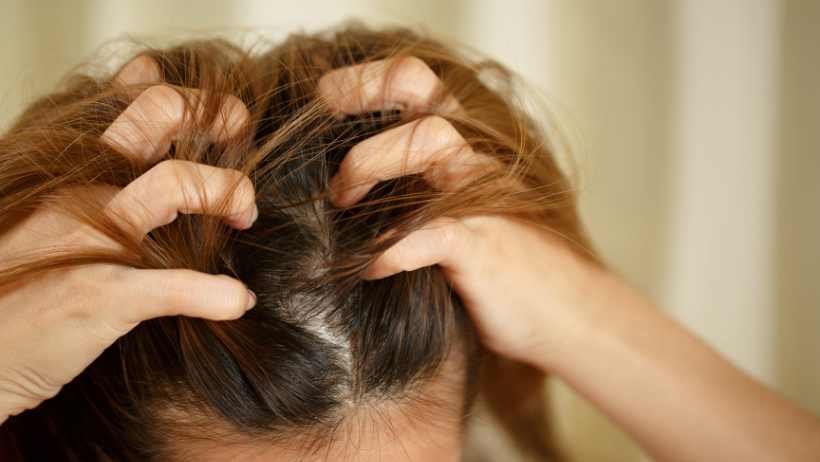
The mixture of sebum, impurities like dust, dirt and dead cells together form wax-like deposits called sebum plugs, also called follicular keratosis or scalp acne [4]. These sebum plugs clog the follicles of your hair and cause dandruff, scalp irritation, and hair loss [5]. These crystallized sebum balls in hair prevent haircare products from penetrating your hair shaft, making your haircare regime ineffective. Too much sebum on your scalp paves the way to bacterial and fungal infection in the scalp. A parasite called demodex folliculorum will lead to the development of hyper seborrhea condition [6].
Functions of Sebum on the Scalp
Sebum is vital in balancing your hair and scalp health in various ways. Some of its functions are:
1. Serves as a Natural Conditioner
Sebum is a natural scalp conditioner offering your hair nourishment and moisture. It is a double protective layer to protect hair from extreme dryness while preventing excess moisture from penetrating your hair shaft.
2. Keeps Your Scalp’s pH Level Balanced
When sebum gets mixed with your body, sweat helps maintain a healthy pH range from 4.5 to 6.2. The acidic pH level aids in protecting your scalp against the attacks of pathogens.
3. Protection Against UV Rays
The natural sebum secreted by sebaceous glands in your body possesses potent antioxidants. It helps in protecting your scalp and hair against the damages done by external factors like UV ray damage, extreme weather, and pollution.
4. Nourishes Hair Shaft
The sebaceous glands produce sebum to keep your hair shafts nourished and hydrated, preventing issues like dryness and brittleness. So, problems like hair breakage and split ends due to dry hair friction, are averted.
5. Antifungal and Antibacterial Prowess
The sebum on your scalp contains triglycerides, which are rich in antifungal and antibacterial properties [7]. This property helps it to fight against fungal and bacterial infections to protect hair health.
6. No Frizz
If your scalp doesn’t produce enough sebum, the cuticle of your hair will open up to let moisture evaporate, resulting in frizziness. Sebum is vital in lowering frizz, making your hair look smooth, soft, and manageable.
7. Heals Wound Quickly
The sebum on your scalp enhances wound healing if you have injured your head by keeping pathogens at bay. It also maintains the right amount of moisture on the scalp to prevent dryness.
What Will Happen When There Is Imbalance in Sebum Production?

Even though the sebum on the scalp is loaded with protective properties, fluctuations in sebum can have adverse effects, such as:
- Acne Breakouts: When the sebum levels secreted on your scalp are more than normal, it can make your scalp greasy and oily, leading to the formation of sebum plugs and acne breakouts.
- Inflamed Scalp: Fluctuations in sebum levels will lead to the development of whiteheads and blackheads on your scalp. So, the scalp pores will get blocked and inflamed, which might worsen due to excess sebum build-up.
- Dandruff: Too much sebum levels on your scalp indicate the onset of a worse hair-related issue, which is dandruff. The sebum teams up with Malassezia Globosa fungi [8] to cause dandruff on the scalp, which will lead to hair loss. This fungus bonds with the sebum to break it down to cause white dead skin flakes, redness, and itching.
- Dryness and Flakiness: When the sebaceous glands fail to produce adequate levels of sebum, it can cause dryness in the scalp and hair. So your scalp will be flaky and itchy, making it prone to severe damage.
What Causes Fluctuations in Sebum Production?
Several factors cause imbalances in sebum production on the scalp. They are:
- Neurological Issues: Excess sebum production is triggered by neurological disorders like Parkinson’s disorders, which make the sebaceous glands secrete excess sebum or hyper seborrhea.
- Hypothyroidism: If your thyroid function is deficient, then it can cause a spike in your testosterone hormone levels, which has a direct impact on your sebum production.
- Haircare Treatments: Perming chemicals and hair coloring products will make your scalp very dry, which will make your sebum glands secrete more oil to compensate for the dehydration.
- Digestive Issues: Liver and intestinal issues will alter your sebum’s chemical makeup to change its oil-rich properties, leading to flakiness.
- Metabolic Issues: If your diet has foods rich in unhealthy fats like trans fats or saturated fats, then it can lead to metabolic disorders. It may affect your sebum secretion levels. Eating foods with high glycemic index would also cause excess sebum secretion [9].
Maintaining a Healthy Sebum Balance
To maintain a healthy scalp without any scalp sebum plugs, follow the regime mentioned below. With a regular haircare routine, you can clear all the crystallized sebum balls on your scalp and maintain healthy sebum levels.
1. Cleansing Hair Properly
The first step to maintaining a perfect sebum balance is to wash away the scalp sebum plugs from your hair. Use warm water to cleanse your hair before applying a mild shampoo with piroctone olamine or salicylic acid [10] and massage it for a few minutes. Use your fingertips to create lather while massaging gently. It will help loosen up all the crystallized sebum balls in hair and scalp. Then, rinse well using warm water and complete your hair routine with a conditioner. Ensure you shampoo thrice a week to keep greasiness off your locks.
2. Regular Brushing
Gently brush your hair every day without scratching your scalp to improve the blood flow in your scalp. When brushing, the sebum in your scalp gets distributed evenly on the strands to enhance the sheen and health. Regular brushing promotes blood circulation and enhances hair growth.
3. Regular Scalp Exfoliation
Like cleansing your scalp regularly, ensure you follow an exfoliation routine with a mild scalp exfoliating product or scalp scrub to keep it clean. You can also mix brown sugar with powdered oatmeal and massage on the scalp every week to remove excess sebum.
4. Get Scalp Massages
Scalp massages can work wonders for your hair by promoting the blood flow to your hair follicles while balancing scalp production.
5. Other tips to maintain healthy scalp
- Avoid using chemical-based products for hair
- Wear a swim cap to protect your scalp during swimming
- Avoid hair dryer and choose an air-dry method to dry hair after shampooing
When to Seek Professional Advice?
If your scalp has painful bumps, gets irritated, itchy, or develops flakes, consult the dermatologists at Kolors Healthcare. Choosing their haircare services would help you get relief from the drastic effects of sebum build-up on the scalp. Their proven haircare methods ensure the accumulation of sebum is alleviated to prevent build-up in the future.
References
- Departments of Dermatology, Venereology, Allergology and Immunology; Dessau Medical Center; Dessau, Germany – https://www.tandfonline.com/doi/full/10.4161/derm.3.1.13900
- Centre of Dermatovenereology; Vilnius University Hospital Santariskiu klinikos; Vilnius, Lithuania – https://www.ncbi.nlm.nih.gov/pmc/articles/PMC3051853/
- San Gallicano Dermatological Institute; IRCCS; Rome, Italy – https://www.ncbi.nlm.nih.gov/pmc/articles/PMC2835893/
- Universitas Gadjah Mada/Dr. Sardjito General Hospital, Yogyakarta – https://pubmed.ncbi.nlm.nih.gov/36349066/
- University of Miami Miller School of Medicine, 1600 NW 10th Avenue, RMSB 2023A, Miami, Florida 33136, USA – https://pubmed.ncbi.nlm.nih.gov/27148560/
- From the Department of Dermatology, STD and Leprosy, Government Medical College, Srinagar, Jammu and Kashmir, India – https://www.ncbi.nlm.nih.gov/pmc/articles/PMC3884930/
- Department of Medicine, Division of Dermatology, University of California, San Diego – https://www.ncbi.nlm.nih.gov/pmc/articles/PMC3174284/
- Juntendo University Graduate School of Medicine, 2-1-1 Hongo, Bunkyo-ku, Tokyo, 113-8421, Japan. – https://pubmed.ncbi.nlm.nih.gov/24792417/
- Howard E. LeWine, MD, Chief Medical Editor, Harvard Health Publishing – https://www.health.harvard.edu
- The Procter & Gamble Company, Mason, Ohio, USA – https://pubmed.ncbi.nlm.nih.gov/34424558/

